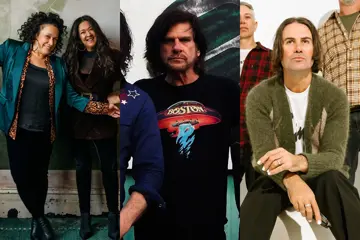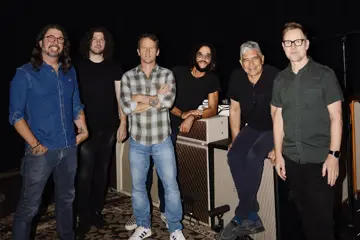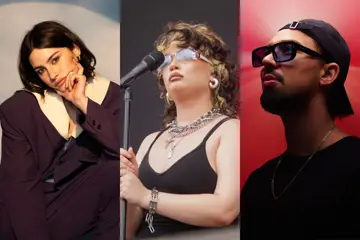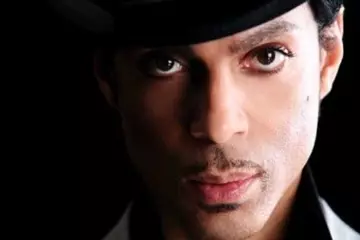 The Amity Affliction
The Amity AfflictionTheMusic.com.au recently ran two stories about remaking of hits – for different reasons.
The Amity Affliction announced they would celebrate the tenth anniversary of their seminal fourth album, Let The Ocean Take Me, by re-recording it and releasing it as Let The Ocean Take Me (Redux), produced by guitarist Dan Brown.
Vocalist Joel Birch said there were several reasons for reworking it. One was that “musically, we felt we could give it a new dynamic.”
But the “more monumental of these” was to cut ties with their previous record label, Roadrunner Records. They claimed the deal, signed when they were younger, “had them taking the vast majority of all revenue from what has been our most successful album until recently.”
The second story was Tina Arena teaming with Melbourne production team SHOUSE to re-do her 1994 hit Chains to include on the 30th anniversary of her album Don’t Ask, which she is touring behind in November.
A well-known example of re-recordings after Taylor Swift got ultra-honked off in 2019 when her former label Big Machine Records, which owned the masters for her first six albums, got sold to Scooter Braun’s Ithaca Recordings.
These were re-done as Taylor’s Version, and new arrangements, vocals, and unreleased demos brought them back into the charts.
Don't miss a beat with our FREE daily newsletter
When Prince’s beef with Warner Music was at its height, the singer-songwriter re-cut 1999 (in the year 1999) and threatened to dole it out to every record he’d made for the major label.
Before he died in 1980, John Lennon wanted to re-record the entire seminal Beatles catalogue “because none of it was as good as how I originally heard it in my head.”
Here are ten more examples of more revisions.
INXS: The Loved One
INXS’s first version of Aussie band The Loved Ones’ 1966 hit The Loved One appeared as a single in 1981 and became their first Top 20 hit.
But by 1987, they’d become enough of a muscular global stadium rock act that they could re-do it for the Kick album with sharp guitars and bass, figuring it’d work better live.
Ironically, Kick was almost in line to press the re-record button. When he first heard it, their US record label head told manager Chris Murphy, “I’ll give you a million dollars to go and record another album. This is not happening, this is shit.” Kick went on to sell 14 million copies worldwide and spun INXS into the stratosphere.
Mike Oldfield - Tubular Bells
With minds expanded by LSD and opportunities of symphony rock, in 1973, it was timely when 19-year-old British musician Mike Oldfield released Tubular Bells. It consisted of two mostly non-vocal first-take tracks on which he played all 20 instruments with 2,000 overdubs.
It was the first release on Richard Branson’s new Virgin Records. Sales were initially slow, and when Branson tried to sell it to America, one exec offered him $20,000 if they added vocals.
But triumph took over when its opening theme was used for the soundtrack to the horror film The Exorcist. Tubular Bells sold 16 million worldwide and was a No. 1 in Australia.
Oldfield always felt that while the record was risky in that it was first-takes, it was inconsistent. He blamed having only a few weeks to record it and the technology of the time for not allowing him to translate his vision.
When the deal with Virgin expired in 1991, he switched to Warner and remixed it. Tubular Bells II sold 2.5 million.
He used the original 16 track tape, which he converted to digital. “One of my first decisions about this remix was to leave it as played,” he relayed.
“There’s a spontaneity about it, a dynamic drive that would’ve been lost, so I left in the squeaks and pops and the few bad notes. They’re far overshadowed by the power and purpose of the playing.”
Rose Tattoo: Rose Tattoo
In 2018, singer Angry Anderson unveiled a five-year plan to wind down the Rose Tattoo story.
But things changed when the latest lineup—including Dai Pritchard (slide guitar), Bob Spencer (guitar), Mark Evans (bass), and Jackie Barnes (drums)—started to explode in Europe and returned to America after 38 years.
The original plan was to re-record the first self-titled album with this lineup as part of the band's 40th anniversary celebration. However, due to heavy touring, they missed the deadline.
But COVID allowed them to re-cut the album as Outlaws, bringing gems such as Rock And Roll Outlaw and Bad Boy For Love to the fore.
Anderson wanted to present the big picture of that first album, including unfinished tracks, songs by the late Ian Rilen (who left early in the piece to form the sonic violent X) like Snow Queen and Sweet Love, and finish off Rosetta which had only been found on Tatts bootlegs.
Anderson told Rockpit the song indicated the role roses played in his life. “My mother’s name is Rose DeMay in Creole-French because she’s Mauritian. My first two tattoos were roses, and I end up in a band called Rose Tattoo.”
Kate Bush – The Kick Inside
Child prodigy Kate Bush had been writing songs since she was 11 and begun demo’ing them with her musician brothers.
However, the music industry thought she and her music were too eccentric, and nothing happened until the demos reached Pink Floyd’s Dave Gilmour.
Bush was 20 in 1978 when her debut album, The Kick Inside, was released. It and its lead-off single, Wuthering Heights, went to No. 1 globally. She had written the song from a TV adaption before reading the book), and she learned to dance to “sell” the songs in music videos.
Follow up The Man With The Child In His Eyes, about how men retained their childishness, was apparently about early boyfriend and future TV presenter Steve Blacknell, who was then cleaning toilets at a Kent mental hospital.
In 2011, the middle-aged Bush revisited some of The Kick Inside and other albums for Director's Cut, delivering them in a lower key and changing drum patterns.
Beck – Modern Guilt
Beck didn't exactly wait for the first version of Modern Guilt before re-recording it. But he had a change of mind during the session. The original plan of ten short songs of 2 minutes each was abandoned when he came more under the spell of producer Danger Mouse (Brian Burton)’s influences.
Instruments were added, and greater American southern influences made themselves felt. At 33 minutes, it was Beck’s shortest record. On its release in mid-2008, it was also his second-biggest album in Australia.
The Police – Don't Stand So Close To Me
In 1980, Don't Stand So Close To Me became The Police’s third No. 1 in the UK.
The song about a teacher’s affair with a student sold 808,000 copies in its first year and reached the Top 10 in Australia, the US, and Canada. It also won a Grammy for Best Rock Performance by a Group.
Six years later, bassist/singer Sting, guitarist Andy Summers, and drummer Stewart Copeland put aside growing inner conflicts to record a new, more ‘80s-sounding version for the Every Breath You Take: The Singles compilation.
"The track is all right, but the original's much better," Summers said in the liner notes to 1993's Message In A Box. "This version took three weeks to record.
“I did my guitar part on the first night, and the rest of the time, it was Sting and Stewart arguing about whether the Fairlight or the Synclavier was better."
These arguments stemmed from the fact that Copeland had a broken collarbone and could not drum. He wanted to use his Fairlight CMI to program the drum track, while Sting pushed to use the drums on his Synclavier instead.
Gloria Gaynor – I Will Survive
US R&B singer Gloria Gaynor didn’t write the dancefloor anthem I Will Survive. It was by two male songwriters who’d just been sacked from Motown Records and determined they would come back.
But when Gaynor first heard it in 1978, she insisted it was "autobiographical".
She’d lost her apartment, grieving the death of her mother, was in hospital after spinal surgery following a fall at a concert and worried she wouldn’t be able to work again. "I was really in a bad place," she said at the time.
Initially, her record company insisted it was a B-side and only gave them 35 minutes to record it. But she and her husband's manager took it to club DJs in New York, who instantly played it, and it became a hit—as a female empowerment, gay, and dance anthem.
Through the years, Gaynor has consistently remixed it and done re-recordings, providing a more contemporary feel each time to appeal to every new generation.
“Through the years, mothers pass it to their daughters, who pass it to their daughters. I want each generation to have their own version. It’s like a family heirloom.”
The message of the chart-topping Grammy-winning 14-million-selling song still resounds with her, the singer said, as she has battled with her management over the years and gone through a divorce.
Rick Wakeman – Journey To The Centre Of The Earth
In 1974, prog-rock Yes’ long-time keyboard player Rick Wakeman came up with the concept of staging a musical adaptation of Jules Verne’s 1864 sci-fi book Journey To The Centre Of The Earth with an orchestra, chamber choir, and rock band.
Faces turned pale when costs blew out to £40,000, which would be £255,204.87 today, or close to AU$500,000. It was decided that rather than cut it in a studio, it would be recorded for cheaper at two epic concerts at London’s Royal Festival Hall. Wakeman sold off some of his car collection and “mortgaged his house to the hilt”.
It was followed by a world tour, which was also a success. Wakeman decided to update it with 18 minutes of music cut from the original piece due to time constraints on vinyl. Alas, the conductor’s original score went missing. It was to be discovered in Australia in 2009.
The manuscripts were water-logged and had to be recreated digitally, and a second album emerged in 2012.
Sherbet – You’ve Got The Gun
“It was our first single to be written by ourselves,” bassist and co-songwriter Tony Michell recalled. It was first recorded for their 1972 debut album with a funky feel.
Four years later, the band’s huge popularity allowed them a bigger recording budget, which gave the song a slicker Motown feel with strings.
Suicidal Tendencies – Suicidal Tendencies
The self-titled debut album of US punk band Suicidal Tendencies made a tremendous impact on its release in July 1983. It was a big seller and set the band up as a major force. Its Institutionalized single got on to MTV, and the album helped shape ‘80s punk and thrash.
But leader Mike Muir clashed with their indie Frontier Records over copyright and royalties and decided to re-record it under the name Still Cyco After All These Years in 1993 (along with two tracks from 1987’s Join The Army) so he could put it out through Epic/Sony.
But it misfired. Many of the band’s fans damned the new recording as lacking the youthful musical attack and realness of the lyrics.

































